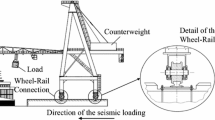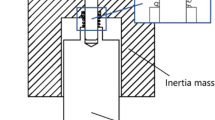Abstract
This paper presents design, implementation and experimental results of active vibration control of a truss structure using a pair of piezoelectric ceramic stack actuators. To reduce the vibrations caused by an impulse force, two active strut members are installed along a vertical of the base bay of the truss. The active strut element consists of a piezoelectric ceramic actuator stack, a force transducer and mechanical interfaces. A self-organizing fuzzy controller (SOFC) is designed to suppress vibration of the truss. The SOFC, which uses the input and output history in its fuzzy rules, is designed to maximize modal damping of a constructed truss structure. Experimental results illustrate that the active piezoceramic strut actuators and the SOFC can effectively reduce vibration of the truss.















Similar content being viewed by others
Abbreviations
- \(A, \;B\) :
-
Antecedent linguistic values
- \(C\) :
-
Consequent linguistic value
- \(g\) :
-
Nonlinear function of the input–output history
- \(h\) :
-
Nonlinear function of the output–input history
- \(i, j\) :
-
Rule index
- \(k\) :
-
Sampled time
- \(p, q\) :
-
Lower and upper limits of the net control range
- \(s\) :
-
Laplace variable
- \(u\) :
-
Control signal
- \(V\) :
-
Control voltage
- \(w\) :
-
Membership degree
- \(y\) :
-
Force transducer signal
- \(\varepsilon\) :
-
Constant to avoid voltage saturation
- \(\mu\) :
-
Membership function
- \(\alpha\) :
-
Target ratio
- \(\omega\) :
-
Resonance frequency
References
Abreu GLCM, Lopes Jr V, Brennan MJ (2010) Robust control of an intelligent truss structure, 10th International Conference on Recent Advances in Structural Dynamics, Southampton University, United Kingdom UK
Abreu GLCM and Lopes Jr V (2010) Active modal damping of truss structure using integral control strategy, XVIII Congresso Brasileiro de Automática, 12 a 16 de setembro
Abreu1 GLCM, Lopes Jr V, Brennan MJ (2010) A self-organizing fuzzy controller for the active vibration control of a smart truss structure. In: M Lallart (ed.) Vibration control, Sciyo, pp. 215–234, ISBN: 978-953-307-117-6
Anderson EH, Moore DM, Fanson JL (1990) Development of an active truss element for control of precision structures. Opt Eng 29(11):1333–1341
Anthony DK, Elliot SJ (2005) On reducing vibration transmission in a two-dimensional cantilever truss structure using geometric optimization and active vibration control techniques. J Acoust Soc Am 110:1191–1194
Burden RL, Faires JD (1989) Numerical analysis, PWS-KENT
Carvalhal R, Lopes V Jr, Brennan MJ (2007) An efficient modal control strategy for the active vibration control of a truss structure. Shock Vib 14:393–406
Chen GS, Lurie BJ, Wada BK (1989) Experimental studies of adaptive structures for precision performance, SDM Conference, pp. 1462–1472
Driankov D, Hellendoorn H, Reinfrank M (1996) An introduction to fuzzy control, 2nd edn. Springer, NY, ISBN: 0-387-56362-8
Fanson JL, Blackwood GH, Chu CC (1989) Active member control of precision structures, SDM Conference, pp. 1480–1494
Li WP, Huang H (2013) Integrated optimization of actuator placement and vibration control for piezoelectric adaptive trusses. J Sound Vib 332:17–32
McClelland R, Lim TW, Bosse AB, Fisher S (1996) Implementation and feedback controllers for vibration suppression of a truss using active struts, Proceedings of the International Society of Optical Engineering Conference on Smart Structures and Materials, San Diego, pp. 452–461
Preumont A, Dufour JP, Malekian C (1992) Active damping by a local force feedback with piezoelectric actuators. J Guid Control Dyn 15:390–395
Preumont A (2002) Vibration control of active structures: an introduction. Kluwer, Brussels, Belgium, ISBN: 1-4020-0496-6
Song G, Vlattas J, Johnson SE, Agrawal BN (1999) Truss active vibration control of a space truss using PZT stack actuator, Am Soc Mech Eng, vol. 59, Aerospace Division
Yan YJ, Yam LH (2002) A synthetic analysis of optimum control for an optimized intelligent structure. J Sound Vib 249:775–784
Zheng K, Zhang Y, Yang Y, Yan S, Dou L, Chen J (2008) Active vibration control of adaptive truss structure using fuzzy neural network Chinese Control and Decision Conference
Acknowledgments
The first author would like to thank the FAPESP (Nº 2008/05129-3) for the financial support of the reported research. The authors acknowledge the financial support of CNPq Brazilian Research Agency and FAPEMIG through INCT-EIE.
Author information
Authors and Affiliations
Corresponding author
Additional information
Technical Editor: Marcelo Savi.
Rights and permissions
About this article
Cite this article
de Abreu, G.L.C.M., de Melo, G.P., Lopes, V. et al. Active modal damping control of a smart truss structure using a self-organizing fuzzy controller. J Braz. Soc. Mech. Sci. Eng. 37, 441–450 (2015). https://doi.org/10.1007/s40430-014-0174-7
Received:
Accepted:
Published:
Issue Date:
DOI: https://doi.org/10.1007/s40430-014-0174-7




